Even with icons like Lydia Lunch, Crass’ Eve Libertine and Chumbawamba’s Alice Nutter (among many others), the rebellious genre of punk rock was due for its own feminist revolt by the late 1980s. The machismo of Glenn Danzig, Henry Rollins and GG Allin still defined much of the punk scene, but the misty Pacific Northwest offered an antidote in the form of the burgeoning riot grrrl movement. Olympia-based Bikini Kill has become the most well known band from this era, but their predecessors date from the early days of punk and their contemporaries stretched across the globe.
The influence of riot grrrl is far reaching throughout both subcultures and popular society. Feminist and queer politics, DIY, zine making, and other forms of democratic and radical expression were at the core of riot grrrl and offered an outlet or a new way of thinking for many who came of age in the 1990s and later. Alien She, on view at the Yerba Buena Center for the Arts, explores the relationship between riot grrrl and seven active visual artists: Tammy Rae Carland, Miranda July, Faythe Levine, Allyson Mitchell, L.J. Roberts, Stephanie Syjuco, and Ginger Brooks Takashi.
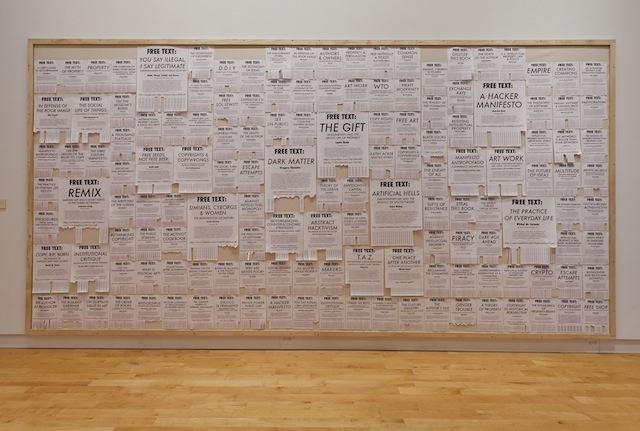
Bay Area artist Stephanie Syjuco’s piece FREE TEXTS (2011-12, updated 2013) is a wall of hundreds of black and white flyers with pull off tabs. Rather than peddling baby or dog sitting services, as such flyers commonly do, the tabs provide links to unauthorized PDF downloads of texts from authors such as Andrea Fraser, Noam Chomsky, and the San Francisco Diggers. The iteration on view in Alien She includes texts from authors that are important to the practices of the other artists in the exhibit.
Though clearly referencing informal neighborhood economies, the work shares a visual style with musicians-wanted ads and the simplest of show flyers. Importantly, the work itself participates in free culture and literary piracy. With the exception of those providing works that may not have copyright protection, such as Guy Debord’s “Theory of the Dérive,” each of these flyers represents a criminal act, though they are in the service of radical politics. And like all works that seem to beckon viewers to touch them without explicitly condoning it, FREE TEXTS flaunts its mischievousness when viewers self-consciously debate whether they’re allowed to engage with the work and take a tab. Through the piece, Syjuco toys with the entire concept of a punk rock museum exhibit.
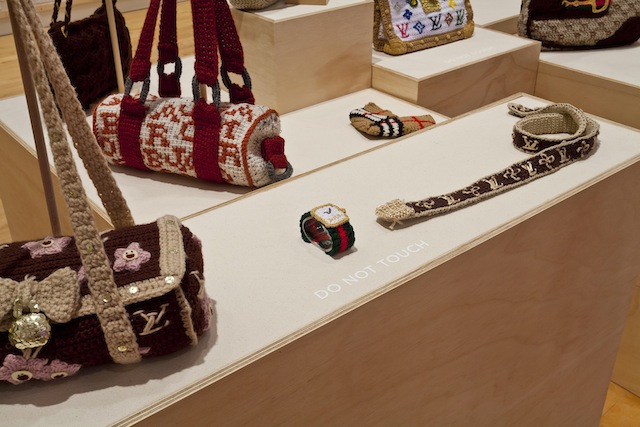
And yet, Syjuco’s The Counterfeit Crochet Project (Critique of a Political Economy) (2006-ongoing) is accompanied by a sign warning viewers to keep their hands to themselves, as is museum tradition. The piece is comprised of several crocheted knockoffs of designer handbags, scarves, and accessories that Syjuco commissioned from various crafters. Though the objects are clearly forgeries, the ability to mimic the qualities that give these items monetary value in the marketplace is made clear. The absurdity of a $1,000 Burberry scarf is hard to ignore when confronted with the open secret that the color scheme and designs that give them so much social capital can be easily replicated.
Bay Area photographer Tammy Rae Carland attended The Evergreen State University in Olympia during the birth of the riot grrrl movement and was involved from the beginning. In the late 1980s, Carland formed a band with future Bikini Kill singer Kathleen Hannah and Heidi Arbogast, now a museum educator in Spokane. The band, Amy Carter, took its name from the former president’s activist daughter and was immortalized by Carland’s zine I (heart) Amy Carter.
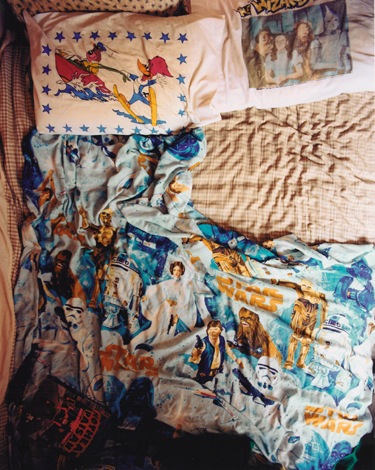
Carland, who left Olympia to pursue an MFA at the University of California, Irvine, offers several photographic projects in Alien She. Untitled (Lesbian Beds) (2002) is a series of portraits of lesbian couples that present only their unmade beds. The individual subjects remain unseen in each photo, but documentation of one of their most intimate spaces discloses much about them, while excluding even more. One bed is adorned with a Star Wars comforter, a Woody Woodpecker pillow, and a Wizard of Oz pillow. A copy of the comic Hothead Paisan: Homicidal Lesbian Terrorist sits idly above the sea of Stormtroopers, waiting patiently for its owner to return to bed. The image suggests a couple that is playful and quite fond of popular culture. But viewers are denied many details of this couple’s life together. Their professions, their ages, their races, even their temperaments (love of Woody Woodpecker notwithstanding) are indiscernible. Viewers may see in this photo, if they chose to, a couple that is ordinary and down to earth, but as complex as any other. Whatever stereotypes might be suggested by the kitschy bedcovers — or the dirty athletic sock and Gertrude Stein book in another photo — are always out of reach, and always without confirmation or denial.
The work of Toronto-based Allyson Mitchell and Brooklyn-based L.J. Roberts dominate the exhibition’s main gallery. Three giant sculptures of found textiles lord over the museum in Mitchell’s installation Ladies Sasquatch (2006-10). The big, burly sasquatches are imposing but also comical. The brawniest of the three seems to roar loudly as she squats over several adorable pink forest creatures that look slightly extraterrestrial. Ladies Sasquatch, as with other work of Mitchell’s, is concerned with the representation of the female body and sexuality and point to a different ethos and aesthetic than mainstream consumer culture.
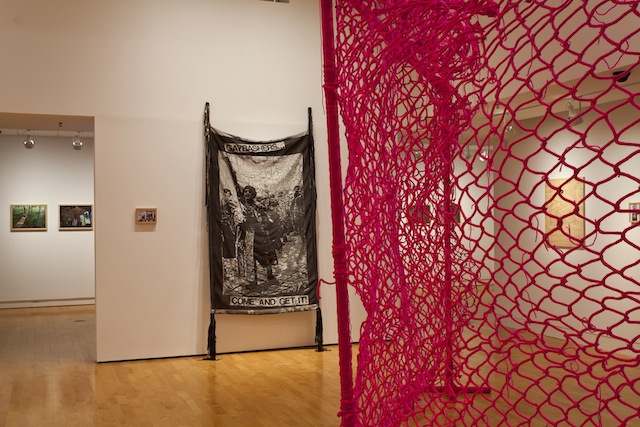
Ladies Sasquatch shares the room with several large knit textiles and a fence made of pink yarn from Roberts. Behind the fence, weaved and knit copies of protest banners hang on the wall, such as Gay Bashers Come And Get It (2011), which appropriates a poster designed by Matt Height. The black and white image features a subject in a long coat confidently and defiantly holding a rifle amidst what looks like a historical protest or insurrection.
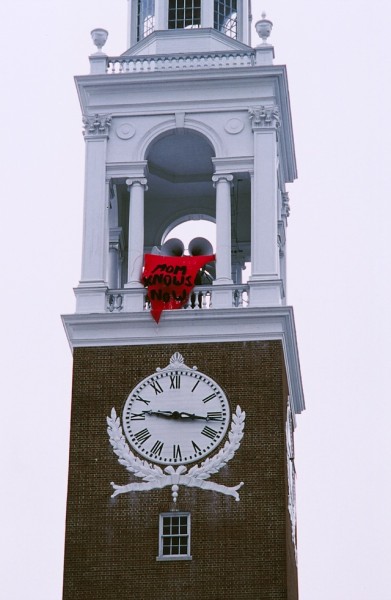
Mom Knows Now (2003) is a ten-by-fifteen foot hand-knit pink triangle emblazoned with the words “mom knows now.” In 2003, Roberts hung the banner from the chapel steeple at the University of Vermont, the artist’s undergraduate alma mater. Though younger than other artists in Alien She, and never directly involved with the riot grrrl movement, Roberts claims inspiration from the DIY and feminist ethics, as well as from Carland, who was a graduate school mentor.
The artwork in Alien She is accompanied with a room full of riot grrrl flyers, hundreds of zines, and a listening station. But this historical documentation is physically segregated from the artists’ work, and the two realms feel detached. The works in the exhibit deal with DIY culture as well as feminist and queer politics, but such an exhibit could exist on its own terms without the riot grrrl foundation. I don’t suggest that the curators should have abandoned the connection between the artists and riot grrrl, but I would have appreciated a deeper exploration of that connection more deeply and a more natural integration of the material culture of the movement with the fine art on display.
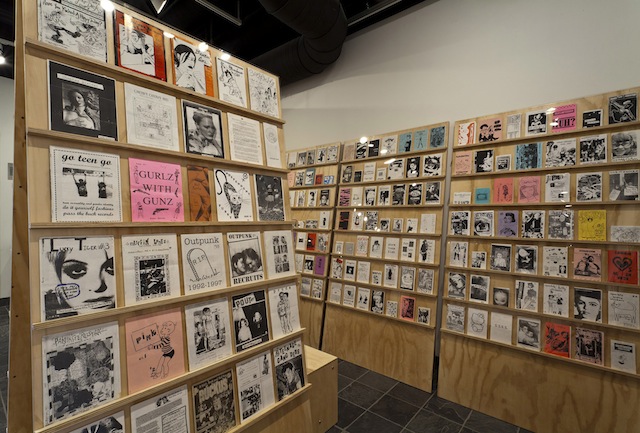
I suspect I will always feel ambivalent about punk rock’s entrée into the world of museums. While the exhibit’s listening station of curated riot grrrl playlists is fantastic, the display of zines seemed antithetical to their own democratic politics. Behind protective glass, the zines were out of reach for viewers and their contents concealed. This is understandable from a conservation standpoint, but therein lies an inherent contradiction with the institutionalization of an anti-institutional and iconoclastic subculture. As punk continues to age, these issues will only become more common. And I certainly appreciate the preservation and analysis of such an important historical movement. I can offer no immediate solutions to this paradox, but by emphasizing the impact of riot grrrl on artists creating radical and subversive work, Alien She does justice to the movement and honors its ethos.
Alien She runs through January 25, 2015 at the Yerba Buena Center for the Arts in San Francisco. For more information visit ybca.org.